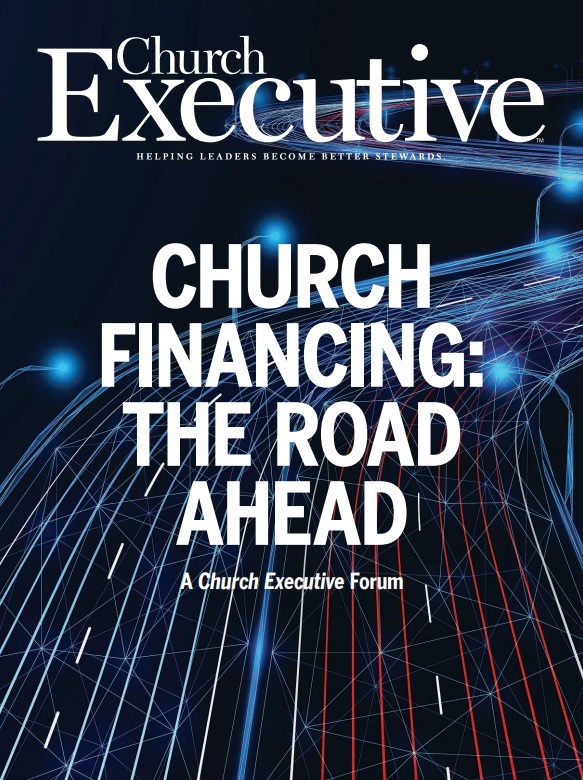
 Supply chain issues. Rising interest rates. A reimagined worship environment. All these factors — and more — are likely to impact church financing now and in years to come.
Supply chain issues. Rising interest rates. A reimagined worship environment. All these factors — and more — are likely to impact church financing now and in years to come.

Senior Relationship Manager
Thrivent Church Financing
Church Executive: Tell me about your organization and its history working with churches.
David Lee: Thrivent has been serving the financing needs of churches for more than 115 years. Thousands of churches have been helped during that time.
Unlike most traditional church lenders, our loans don’t mature in a few years with balloon payments, as we’re able to offer simple-to-understand fixed-rate loans for up to 25 years.
Also, transitioning a church’s banking / cash management services is not a requirement, which frees up the church to work with the lender of its choice.
CE: Compare 2022 to 2021 in terms of construction financing. What differences are you seeing?
Lee: We continued to see historic low interest rates without much volatility through the end of 2021 — but that has changed. With overall construction costs rising (materials, labor, supply chain issues) — combined with the likelihood of continued rising interest rates in 2022 and beyond, according to many economists — churches are having to re-engineer the scope of their projects by possibly phasing their original plans.
Rising interest rates means a church may qualify for a lower loan amount, resulting in that church having to raise more funds for a project.
It’s essential that a church obtains a GMP / GMAX (guaranteed maximum price) contract from general contractors to protect itself from rising construction costs that could derail its project, as most experienced church lenders will require it.
Finding lenders willing to extend rate locks during a rising-interest-rate environment may also be challenging.
CE: Likewise, how does financing right now compare to pre-pandemic?

Lee: Construction financing requirements remain relatively the same — stable / strong giving, attendance, liquidity, adequate loan-to-value, and independent board governance. However, some critical metrics that lenders analyze might need additional clarification.
Pre-pandemic, physical in-person attendance figures were easy to identify. Because online attendance / viewership has now become an integral part of many churches, it’s important that they’re able to monitor, track and translate those figures.
Many lenders have begun looking at “giving units” as a more accurate measurement of church growth. As a main principle, be able to explain any significant variances of data submitted to the lender.
CE: Have you seen any trends related to the kinds of facilities churches are building, both during and post-pandemic?
Lee: Time has yet to tell what sustainable trends will emerge due to the pandemic. But with current sanctuary seating capacities still not reaching pre-pandemic levels, we might see fewer “mega” 2,000-plus-seat sanctuaries; rather, we might witness the acceleration of building multipurpose facilities or acquiring satellite locations.
In addition, we might continue to see more struggling churches seeking to be acquired / merged. Often, these facilities appear outdated and require significant renovations.
CE: Do you anticipate any pandemic-centric construction financing “trends” carrying forward?
Lee: Compared to the 2008 recession, many churches were much quicker to identify potential expense reductions when COVID struck. It will remain important for churches to be mindful about monitoring expenses in response to giving trends.
Some churches have experienced exponential growth in online viewership and giving; however, an experienced lender will want to know the sustainability of such growth.
While the financial health of a church has and will continue to be at the core of qualifying for financing moving forward, there continues to be emphasis on strong leadership governance that embraces accountability, transparency, and are led by a truly independent board.
Many lenders have begun looking at ‘giving units’ as a more accurate measurement of church growth [than in-person attendance]. As a main principle, be able to explain any significant variances of data submitted to the lender.
Also, the pandemic has provided an opportunity for churches to take a deep “pause” to reevaluate everything in the church — staffing, effectiveness of current programs, building use, technological capabilities, and the exciting opportunities associated with the birth of an “online” congregation for many.
Finally, please(!) talk with an experienced lender before you spend any money on your project to determine what your ministry can reasonably afford. Failure to do so could result in significant delays, unusable plans, increased overall costs, and broken trust / confidence with the congregation.
CE: What are your thoughts on when (or if) church financing will be ‘back to normal’?
Lee: That’s very difficult to say. Regardless of when (or if) “normal” comes, reputable church lenders that have been serving ministries for many years will adjust accordingly to the unique growing needs of churches and continue to lend. Churches will continue to be evaluated based on the same general criteria.
The most significant pandemic-related disruption for churches was their inability to have in-person worship, which brought some anxiety to lenders as to how giving would be impacted. Proven once again, the Church, despite facing extraordinary challenges, has come out stronger and is more committed to accomplishing the Great Commission.
David Lee holds a bachelor’s degree in Finance from Cal State Fullerton and a master’s degree in Christian Education from Talbot Seminary.


